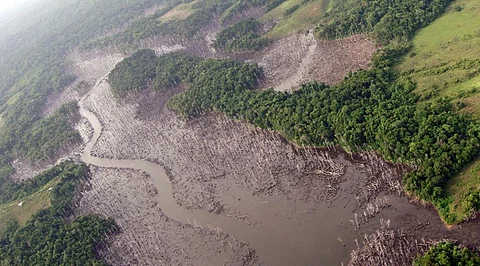

The Sumatra-Andaman earthquake that took place 18 years ago on Boxing Day (December 26, 2004) was so big that its effects were felt as far as Alaska. New insights continue to be added about the quake and the lethal tsunami it unleashed as technology upgrades itself. Latest studies have revised the figure about how big the ‘rupture’ caused by the quake actually was.
A study by Japanese and Chinese physicists last year noted that the rupture’s total length was 1,400 km. This is longer than previous estimates that have put the figure at 1,200 to 1,300 km or the entire length of the US state of California.
The US Geological Survey had noted in an assessment titled Tsunami Generation from the 2004 M=9.1 Sumatra-Andaman Earthquake in 2018:
Like a propagating crack in a frozen lake, the rupture front for this earthquake moved at a high speed of approximately 2.5 km/s, typical for subduction zone earthquakes. It took approximately 8 minutes for the rupture front to propagate from the hypocentre to the end of its journey 1,200 km away (approximately the length of California!)
Contrast that with what Re-examination of Slip Distribution of the 2004 Sumatra–Andaman Earthquake (Mw 9.2) by the Inversion of Tsunami Data Using Green’s Functions Corrected for Compressible Seawater Over the Elastic Earth noted last year:
The significant slips from the epicenter to the northern area yield total source length of about 1400 km along the trench.
The authors of the study published in the journal Pure and Applied Geophysics used sea surface height (SSH) data from satellite altimetry (SA) measurements along five tracks, and the tsunami waveforms recorded at tide gauges (TG) and ocean bottom pressure gauges (OBPG) in and around the Indian Ocean.
“Phase-correction effects are not so significant for stations or data points within the Indian Ocean, however, the reproducibility of SSHs by SA measurements and tsunami waveforms at TGs and OBPGs around the Indian Ocean are significantly improved,” they wrote.
The location of the 2004 quake and subsequent tsunami is an important, though understudied one. It is where the Indo-Australian tectonic plate – a body of rock — is grinding against the Burma plate, which is part of the Eurasian plate.
Millions of years ago, the supercontinent Pangea split into two: Laurasia (Europe, North America and Asia excluding India) and Gondwana (South America, Africa, Madagascar, Indian subcontinent and Australia).
Later, the Indian subcontinent moved northward and joined Asia, forming the Himalayas. But the Indian plate continues to ‘subduct’ or go below the Eurasian plate, leading to deadly quakes across the Himalayas and Inner Asia.
Similarly, the Indian plate continues to subduct beneath the Burma plate. On December 26, 2004, stress built up over thousands of years due to the subduction process, caused the two plates to break free or to ‘slip’, causing the quake and the tsunami.
“After centuries or even thousands of years, the upper plate will suddenly break free and rebound, slipping by tens of feet (several meters) in a matter of seconds, and generating a giant earthquake,” an article by the Tectonics Laboratory of the California Institute of Technology notes.
It adds:
Rather than tearing the land apart all at once, the rupture started beneath the epicenter and progressed northward along the fault at about 2 km/sec (1.2 miles/second). The whole rupture lasted about 10 minutes.
Ten minutes was the time for which the quake lasted. It caused the displacement of water that took the form of a series of waves 30 feet high, known as tsunami or ‘harbour wave’ in Japanese.
‘Giant Earthquakes’ similar to the one in Sumatra and Andaman include the 1960 Chile Quake and the 2011 Tohoku Quake.